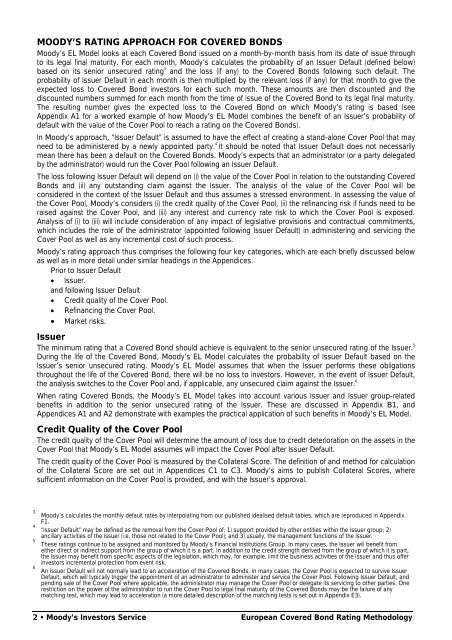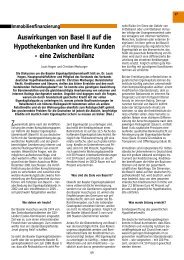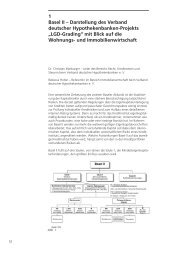Expected Loss Covered Bond Model
Expected Loss Covered Bond Model
Expected Loss Covered Bond Model
Create successful ePaper yourself
Turn your PDF publications into a flip-book with our unique Google optimized e-Paper software.
MOODY’S RATING APPROACH FOR COVERED BONDS<br />
Moody’s EL <strong>Model</strong> looks at each <strong>Covered</strong> <strong>Bond</strong> issued on a month-by-month basis from its date of issue through<br />
to its legal final maturity. For each month, Moody’s calculates the probability of an Issuer Default (defined below)<br />
based on its senior unsecured rating 3<br />
and the loss (if any) to the <strong>Covered</strong> <strong>Bond</strong>s following such default. The<br />
probability of Issuer Default in each month is then multiplied by the relevant loss (if any) for that month to give the<br />
expected loss to <strong>Covered</strong> <strong>Bond</strong> investors for each such month. These amounts are then discounted and the<br />
discounted numbers summed for each month from the time of issue of the <strong>Covered</strong> <strong>Bond</strong> to its legal final maturity.<br />
The resulting number gives the expected loss to the <strong>Covered</strong> <strong>Bond</strong> on which Moody’s rating is based (see<br />
Appendix A1 for a worked example of how Moody’s EL <strong>Model</strong> combines the benefit of an Issuer’s probability of<br />
default with the value of the Cover Pool to reach a rating on the <strong>Covered</strong> <strong>Bond</strong>s).<br />
In Moody’s approach, “Issuer Default” is assumed to have the effect of creating a stand-alone Cover Pool that may<br />
need to be administered by a newly appointed party. 4 It should be noted that Issuer Default does not necessarily<br />
mean there has been a default on the <strong>Covered</strong> <strong>Bond</strong>s. Moody’s expects that an administrator (or a party delegated<br />
by the administrator) would run the Cover Pool following an Issuer Default.<br />
The loss following Issuer Default will depend on (i) the value of the Cover Pool in relation to the outstanding <strong>Covered</strong><br />
<strong>Bond</strong>s and (ii) any outstanding claim against the Issuer. The analysis of the value of the Cover Pool will be<br />
considered in the context of the Issuer Default and thus assumes a stressed environment. In assessing the value of<br />
the Cover Pool, Moody’s considers (i) the credit quality of the Cover Pool, (ii) the refinancing risk if funds need to be<br />
raised against the Cover Pool, and (iii) any interest and currency rate risk to which the Cover Pool is exposed.<br />
Analysis of (i) to (iii) will include consideration of any impact of legislative provisions and contractual commitments,<br />
which includes the role of the administrator (appointed following Issuer Default) in administering and servicing the<br />
Cover Pool as well as any incremental cost of such process.<br />
Moody’s rating approach thus comprises the following four key categories, which are each briefly discussed below<br />
as well as in more detail under similar headings in the Appendices.<br />
Prior to Issuer Default<br />
• Issuer.<br />
and following Issuer Default<br />
• Credit quality of the Cover Pool.<br />
• Refinancing the Cover Pool.<br />
• Market risks.<br />
Issuer<br />
The minimum rating that a <strong>Covered</strong> <strong>Bond</strong> should achieve is equivalent to the senior unsecured rating of the Issuer. 5<br />
During the life of the <strong>Covered</strong> <strong>Bond</strong>, Moody’s EL <strong>Model</strong> calculates the probability of Issuer Default based on the<br />
Issuer’s senior unsecured rating. Moody’s EL <strong>Model</strong> assumes that when the Issuer performs these obligations<br />
throughout the life of the <strong>Covered</strong> <strong>Bond</strong>, there will be no loss to investors. However, in the event of Issuer Default,<br />
the analysis switches to the Cover Pool and, if applicable, any unsecured claim against the Issuer. 6<br />
When rating <strong>Covered</strong> <strong>Bond</strong>s, the Moody’s EL <strong>Model</strong> takes into account various Issuer and Issuer group-related<br />
benefits in addition to the senior unsecured rating of the Issuer. These are discussed in Appendix B1, and<br />
Appendices A1 and A2 demonstrate with examples the practical application of such benefits in Moody’s EL <strong>Model</strong>.<br />
Credit Quality of the Cover Pool<br />
The credit quality of the Cover Pool will determine the amount of loss due to credit deterioration on the assets in the<br />
Cover Pool that Moody’s EL <strong>Model</strong> assumes will impact the Cover Pool after Issuer Default.<br />
The credit quality of the Cover Pool is measured by the Collateral Score. The definition of and method for calculation<br />
of the Collateral Score are set out in Appendices C1 to C3. Moody’s aims to publish Collateral Scores, where<br />
sufficient information on the Cover Pool is provided, and with the Issuer’s approval.<br />
3<br />
4<br />
5<br />
6<br />
Moody’s calculates the monthly default rates by interpolating from our published idealised default tables, which are reproduced in Appendix<br />
F1.<br />
“Issuer Default” may be defined as the removal from the Cover Pool of: 1) support provided by other entities within the Issuer group; 2)<br />
ancillary activities of the Issuer (i.e. those not related to the Cover Pool); and 3) usually, the management functions of the Issuer.<br />
These ratings continue to be assigned and monitored by Moody’s Financial Institutions Group. In many cases, the Issuer will benefit from<br />
either direct or indirect support from the group of which it is a part. In addition to the credit strength derived from the group of which it is part,<br />
the Issuer may benefit from specific aspects of the legislation, which may, for example, limit the business activities of the Issuer and thus offer<br />
investors incremental protection from event risk.<br />
An Issuer Default will not normally lead to an acceleration of the <strong>Covered</strong> <strong>Bond</strong>s. In many cases, the Cover Pool is expected to survive Issuer<br />
Default, which will typically trigger the appointment of an administrator to administer and service the Cover Pool. Following Issuer Default, and<br />
pending sale of the Cover Pool where applicable, the administrator may manage the Cover Pool or delegate its servicing to other parties. One<br />
restriction on the power of the administrator to run the Cover Pool to legal final maturity of the <strong>Covered</strong> <strong>Bond</strong>s may be the failure of any<br />
matching test, which may lead to acceleration (a more detailed description of the matching tests is set out in Appendix E3).<br />
2 • Moody’s Investors Service European <strong>Covered</strong> <strong>Bond</strong> Rating Methodology

















